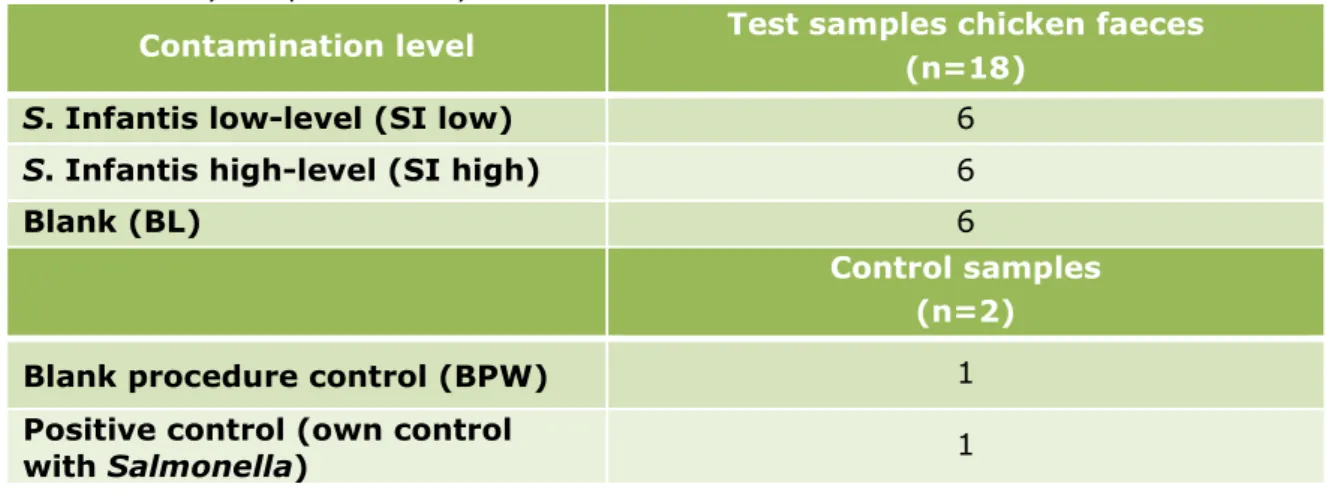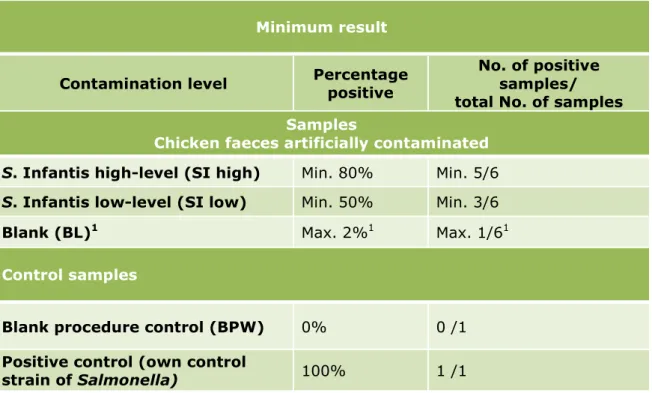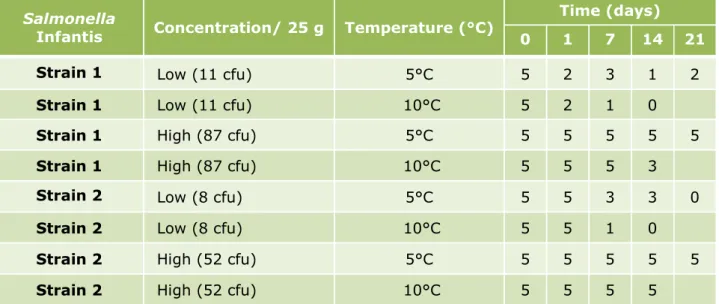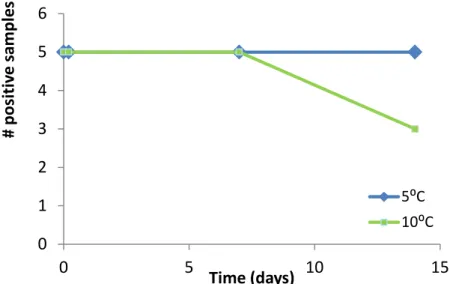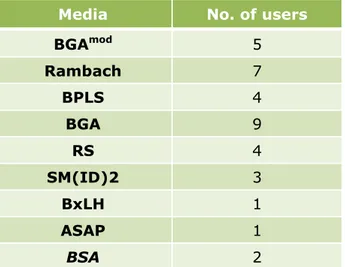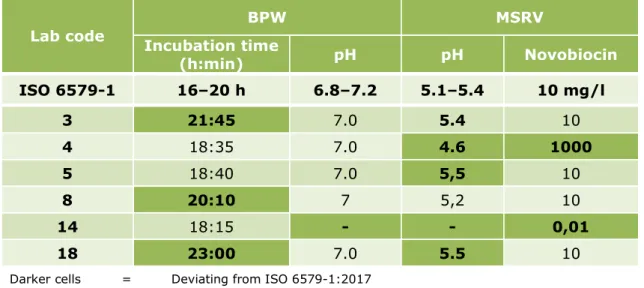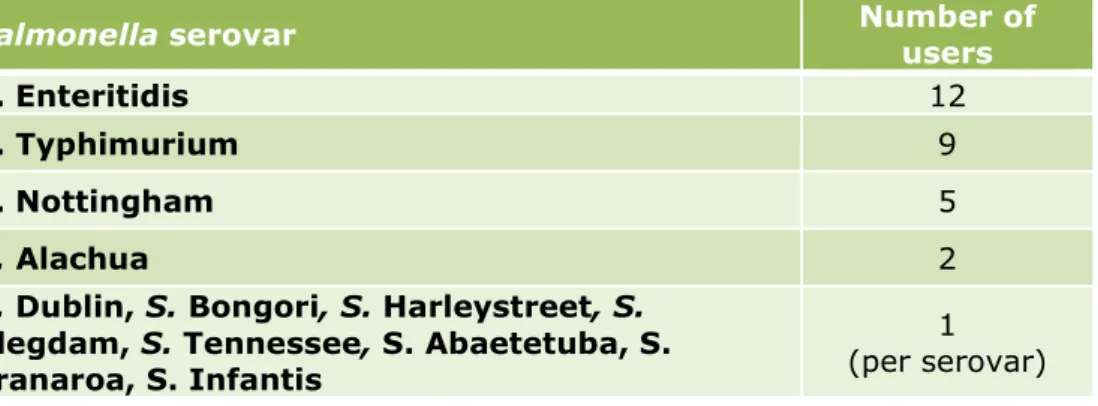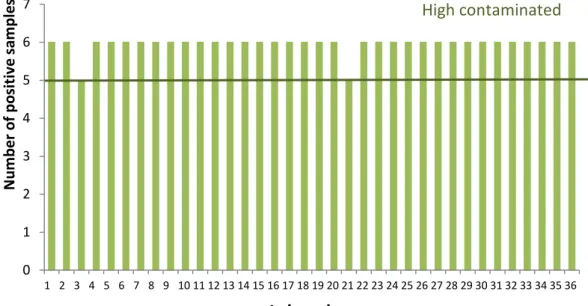The 20th EURL-Salmonella
interlaboratory comparison
study primary production (2017)
Detection of Salmonella in chicken faeces
This report contains an erratum
d.d. 17-7-2018 after page 34
RIVM Report 2017-0083
Page 2 of 34
Colophon
© RIVM 2018
Parts of this publication may be reproduced, provided acknowledgement is given to: National Institute for Public Health and the Environment, along with the title and year of publication.
DOI 10.21945/RIVM-2017-0083
I.E. Pol-Hofstad (author), RIVM K.A. Mooijman (author), RIVM Contact:
Irene Pol-Hofstad
Centre for Zoonoses and Environmental Microbiology (Z&O) Irene.Pol@RIVM.nl
This investigation was performed by order and for the account of European Commission, Directorate-General for Health and Food Safety (DG-SANTE), within the framework of RIVM project number
E/114506/17/RO European Union Reference Laboratory for Salmonella 2017
This is a publication of:
National Institute for Public Health and the Environment
P.O. Box 1 | 3720 BA Bilthoven The Netherlands
Synopsis
The 20th EU Interlaboratory comparison study in primary production
(2017)
Detection of Salmonella in chicken faeces
In March 2017, the twentieth EURL-Salmonella interlaboratory comparison study on the detection of Salmonella in samples taken from the primary production stage was organised. Participation was obligatory for all EU Member State National Reference Laboratories (NRLs) responsible for the detection of Salmonella in these types of samples.
Results
All laboratories were able to detect Salmonella in all the contaminated chicken faeces samples. Both the blank control sample and the positive control sample were analysed correctly by all laboratories. One laboratory made a labelling mistake and switched the process control for the positive control and therefore scored a ‘moderate performance’.
Blank samples containing chicken faeces not contaminated with Salmonella were correctly analysed as negative by almost all laboratories. One laboratory found Salmonella present in 3 of the 6 blank samples; this was indicated as a ‘poor performance’.
Participants
In total, 36 NRLs participated in this study: 29 NRLs from 28 EU Member States, 6 NRLs from other countries in Europe (EU candidate or potential EU candidate Member States and countries of the European Free Trade
Association (EFTA)) and, on request of the European Commission, one NRL from a non-European country. EURL-Salmonella is situated at the Dutch National Institute for Public Health and the Environment (RIVM). The main task of EURL-Salmonella is to monitor and improve the performance of the national reference laboratories in Europe.
Design of study
Each laboratory received a package of chicken faeces samples. The samples were contaminated by the EURL-Salmonella at two different Salmonella concentrations: high and low. The package also included blank samples without Salmonella. The laboratories were asked to analyse the samples according to the internationally prescribed method for the detection of Salmonella.
Keywords: Salmonella, EURL, NRL, interlaboratory comparison study, Salmonella detection method, chicken faeces
Publiekssamenvatting
Het 20e EURL-Salmonella ringonderzoek primaire productie (2017) Detectie van Salmonella in kippenmest
In maart 2017 vond het twintigste EURL-Salmonella ringonderzoek naar Salmonella plaats. Deze jaarlijkse kwaliteitstoets is verplicht voor alle Nationale Referentie Laboratoria (NRL’s) van de Europese lidstaten die verantwoordelijk zijn voor het aantonen van Salmonella in dierlijke mest.
Resultaten
Alle deelnemers waren in staat om Salmonella op te sporen in de kunstmatig besmette kippenmestmonsters. Ook hebben de laboratoria de meegestuurde controlemonsters correct geanalyseerd. Eén laboratorium heeft een fout gemaakt met het labelen van de monsters en heeft daardoor de twee controlemonsters verwisseld. Hiervoor kreeg dit laboratorium een matige score. Bijna alle laboratoria konden de monsters waar geen Salmonella aan was toegevoegd (blanco) als zodanig opsporen. Eén laboratorium vond echter Salmonella in drie van de zes blanco monsters en scoorde daardoor een onvoldoende.
Deelnemers
In totaal hebben 36 NRL’s deelgenomen: 29 NRL’s van 28 lidstaten in de EU, zes NRL’s uit kandidaat-landen voor het EU-lidmaatschap of landen van de European Free Trade Association (EFTA) en één niet-Europees NRL dat op verzoek van de Europese Commissie is toegevoegd (Israël). Het Europese Referentie Laboratorium (EURL) Salmonella is gevestigd bij het Nederlandse Rijksinstituut voor Volksgezondheid en Milieu (RIVM). De hoofdtaak van het EURL-Salmonella is toezien op de kwaliteit van de nationale
referentielaboratoria voor deze bacterie in Europa.
Werkwijze
Elk laboratorium kreeg een pakket toegestuurd met daarin de monsters met kippenmest. De kippenmest is op het EURL-laboratorium besmet met de Salmonella-bacterie in twee concentraties (hoog en laag). Ook zijn er onbesmette blanco monsters meegestuurd. De laboratoria dienden de monsters te analyseren volgens de internationaal voorgeschreven methode op de aanwezigheid van Salmonella.
Kernwoorden: Salmonella, EURL, NRL, ringonderzoek, kippenmest, Salmonella-detectiemethode.
Contents
Summary — 9 1 Introduction — 11 2 Participants — 13
3 Materials and methods — 15
3.1 Preparation of artificially contaminated chicken faeces samples — 15 3.1.1 General — 15
3.1.2 Pre-tests for the preparation of chicken faeces samples — 15
3.1.3 Preparation of the chicken faeces samples for the interlaboratory comparison study — 15
3.1.4 Determination of amount of background flora in chicken faeces — 15 3.1.5 Determination of the number of Salmonella in chicken faeces
samples by MPN — 15
3.2 Design of the interlaboratory comparison study — 16 3.2.1 Number and type of samples — 16
3.2.2 Sample packaging and temperature recording during shipment — 16 3.3 Methods — 16
3.4 Statistical analysis of the data — 17 3.5 Criteria for good performance — 17
4 Results and discussion — 19
4.1 Preparation of artificially contaminated chicken faeces — 19 4.1.1 Pre-tests for the preparation of chicken faeces samples — 19
4.1.2 Preparation of the chicken faeces samples for interlaboratory comparison study — 20
4.1.3 Background flora in chicken faeces — 20
4.1.4 Number of Salmonella in chicken faeces samples — 21 4.2 Technical data interlaboratory comparison study — 21 4.2.1 General — 21 4.2.2 Accreditation — 21 4.2.3 Transport of samples — 22 4.2.4 Media — 22 4.3 Control samples — 23 4.3.1 General — 23
4.3.2 Correct scores of the control samples — 24
4.4 Artificially contaminated chicken faeces samples — 25 4.4.1 General — 25
4.4.2 Specificity, sensitivity and accuracy rates for the artificially contaminated samples — 26 4.5 PCR (own method) — 27 4.6 Performance of NRLs — 28 4.6.1 General — 28 5 Conclusion — 29 List of abbreviations — 31 References — 33
Summary
In March 2017, the twentieth EURL-Salmonella interlaboratory comparison study on the detection of Salmonella in samples from the primary
production stage was organised. A total o f 36 NRLs participated in this study: 29 NRLs from 28 EU Member States, 6 NRLs from third countries within Europe (EU candidate or potential EU candidate Member States) and countries of the European Free Trade Association (EFTA)), and on request of DG-SANTE, one NRL from a non-European country (Israel). In this study, Salmonella free chicken faeces originating from a specific pathogen free (SPF) laying hen farm was used. The chicken faeces samples were artificially contaminated with a diluted culture of Salmonella Infantis at the EURL laboratory.
Each NRL received a total of 20 blindly coded samples consisting of
12 chicken faeces samples artificially contaminated with two different levels of Salmonella Infantis (6x low (17 cfu/25 g faeces) and 6x high (55 cfu/25 g faeces)), 6 blanc chicken faeces samples and 2 control samples consisting of a procedure control blank and a control sample to be inoculated by the
participants using their own positive control strain. The samples were stored at 5 °C until the day of transport. On Monday 13 March 2017, the
contaminated chicken faeces samples were packed and sent to the NRLs. On arrival, the NRLs were asked to store the samples at 5 °C until the start of the analysis.
Method
All laboratories used the prescribed method (Annex D of ISO 6579:2007 or ISO 6579-1:2017) with selective enrichment on MSRV.
Results control samples
All laboratories scored well analysing both the procedure control as well as their own positive control samples. One laboratory made a labelling mistake and switched the process control for the positive control. This laboratory (lab code 16) scored a moderate performance.
Results artificially contaminated chicken faeces samples
Almost all laboratories detected Salmonella in all the chicken faeces samples contaminated with a high level of Salmonella. Two laboratories (lab codes 3 and 21) scored 1 of the 6 high level samples negative. This is still within the criteria for good performance which allows for 1 negative sample.
In addition, almost all laboratories detected Salmonella in all 6 low level samples. Three laboratories (lab codes 9, 34 and 36) scored 1 of the 6 low level samples negative for Salmonella. This is well above the criteria for good performance which allows for three negative samples out of 6. The sensitivity score was 99% for these samples.
Page 10 of 34
The specificity of the study is given by the correctly scored blank samples; this was 99% for this study. Only 1 laboratory did not score all 6 blank samples negative (lab code 18). This laboratory reported 3 of the 6 blank samples positive for Salmonella and scored a poor performance.
Overall, the laboratories scored well in this interlaboratory study. The accuracy was 99%. Thirty-four laboratories fulfilled the criteria of good performance, one laboratory scored moderate performance, and one
laboratory scored poor performance. An offer for a follow-up study received no reaction.
1
Introduction
An important task of the European Union Reference Laboratory for
Salmonella (EURL-Salmonella), as laid down in Commission Regulation No 882/2004 (EC, 2004), is the organisation of interlaboratory comparison studies to test the performance of the National Reference Laboratories (NRLs) for Salmonella. The history of the interlaboratory comparison studies as organised by EURL-Salmonella (formerly called CRL-Salmonella) from 1995 onwards is summarised on the EURL-Salmonella website
(http://www.eurlsalomonella.eu).
In March 2017, the EURL-Salmonella organised an interlaboratory study to test whether the NRLs for Salmonella could detect Salmonella at different contamination levels in chicken faeces samples. The results from
interlaboratory studies like this show whether the examination of samples in the EU Member States (EU-MS) is carried out uniformly and whether
comparable results can be obtained by all NRLs-Salmonella.
The method prescribed for the detection of Salmonella spp. in animal faeces, with selective enrichment on Modified Semi-solid Rappaport-Vassiliadis (MSRV), is set out in ISO 6579:2002/Amd 1:2007 recently replaced by ISO 6579-1:2017.
The study design of this study was comparable to previous interlaboratory comparison studies. For this study, the chicken faeces was artificially contaminated with a diluted culture of Salmonella Infantis (SI) at the EURL-Salmonella laboratory.
In total, 18 samples with chicken faeces were tested: six samples per contamination level (blank, low and high concentrations of Salmonella Infantis). Additionally, two control samples were tested: one procedure control and one positive control. The number and contamination levels of the samples were in accordance with ISO/TS 22117:2010.
2
Participants
Country City Institute
Austria Graz Austrian Agency for Health and Food Safety (AGES IMED/VEMI)
Belgium Brussels Scientific Institute of Public Health (WIV-ISP)
Bosnia-Herzegovina Sarajevo Veterinary Faculty of Sarajevo Laboratory for bacterial disease in poultry
Bulgaria Sofia National Diagnostic and Research Veterinary Institute (NDRVMI), National Reference Centre of Food Safety
Croatia Zagreb Croatian Veterinary Institute Poultry Centre, Laboratory for General Bacteriology and Microbiology
Cyprus Nicosia Cyprus Veterinary Services Pathology, Bacteriology, Parasitology Laboratory
Czech
Republic Prague State Veterinary Institute
Denmark Ringsted Danish Veterinary and Food Administration
Estonia Tartu Estonia Veterinary and Food Laboratory, Bacteriology-Pathology Department
Finland Kuopio Finnish Food Safety Authority Evira Research Department, Veterinary Bacteriology
France Ploufragan Anses, Laboratoire de Ploufragan-Plouzané Unité Hygiène et Qualité des Produits Avicoles et Porcins (HQPAP)
Germany Berlin Federal Institute for Risk Assessment (BfR) National Veterinary Reference Laboratory for Salmonella
Greece Chalkida Veterinary Laboratory of Chalkida
Hungary Budapest National Food Chain Safety Office, Food and Feed Safety Directorate
Iceland Reykjavik Matís ohf, Icelandic Food and Biotech R&D
Ireland,
Republic of Kildare
Central Veterinary Research Laboratory (CVRL/DAFFM)
Laboratories Backweston, Department of Agriculture, Food and the Marine, Bacteriology
Israel Kiryat Malachi Southern Poultry Health Laboratory (Beer Tuvia)
Italy Padova Legnaro Istituto Zooprofilattico Sperimentale delle Venezie, OIE National Reference Laboratory for Salmonella
Latvia Riga Institute of Food Safety, Animal Health and Environment BIOR Animal Disease Diagnostic Laboratory
Page 14 of 34
Country City Institute
Luxembourg Luxembourg Laboratoire de Médecine Vétérinaire de l’Etat, Animal Zoonosis
Macedonia,
FYR of Skopje Food Institute, Faculty of Veterinary Medicine Laboratory for food and feed microbiology
Malta Valletta Public Health Laboratory (PHL) Evans Building
Netherlands,
the Bilthoven
National Institute for Public Health and the Environment (RIVM/Cib)
Centre for Infectious Diseases Control
Centre for Zoonoses and Environmental Microbiology (Z&O)
Norway Oslo Norwegian Veterinary Institute, Section of Bacteriology
Poland Pulawy National Veterinary Research Institute (NVRI) Department of Microbiology
Portugal Oeiras Instituto Nacional de Investigação Agrária e Veterinária (INIAV) Unidade de Produção e Saúde Animal Laboratorio de Bacteriologia
Romania Bucharest Institute for Diagnosis and Animal Health, Bacteriology
Serbia Belgrade Institute of Veterinary Medicine of Serbia
Slovak
Republic Bratislava State Veterinary and Food Institute Reference Laboratory for Salmonella
Slovenia Ljubljana National Veterinary Institute, Veterinary Faculty
Spain Madrid Algete Laboratorio Central de Veterinaria Sweden Uppsala National Veterinary Institute (SVA), Department of Bacteriology
Switzerland Bern
National Centre for Zoonoses, Bacterial Animal Diseases and Antimicrobial Resistance (ZOBA), Institute of veterinary
bacteriology, Vetsuisse faculty Berne
United Kingdom
Addlestone Animal Health and Veterinary Laboratories Agency (AHVLA) Weybridge, Bacteriology Department Belfast Agri-Food and Bioscience Institute (AFBI) Veterinary Sciences Division Bacteriology
3
Materials and methods
3.1 Preparation of artificially contaminated chicken faeces samples
3.1.1 General
The matrix in this interlaboratory comparison study was chicken faeces from a pathogen-free (SPF) laying hen farm. The batch of faeces was collected by the Animal Health Service (GD) Deventer from a laying hen flock in Deventer (GD, Deventer, NL). The chicken faeces was artificially contaminated with a diluted culture of Salmonella at the laboratory of the EURL-Salmonella. 3.1.2 Pre-tests for the preparation of chicken faeces samples
The batch of faeces (5 kg) for the pre-test arrived at the EURL on 21 November 2016 and was stored at 5 °C. Immediately on receipt,
five samples of 25 grams were taken randomly from the batch and tested for the presence of Salmonella according to ISO 6579-1:2017.
The chicken faeces samples (25 g) were then artificially contaminated with a high or a low concentration of a diluted culture of Salmonella Infantis culture (own culture collection). To test the stability of the contaminated chicken faeces samples, they were stored at 5 °C and 10 °C for a period of 0, 7, 14 and 21 days, and tested for the presence of Salmonella according to ISO 6579-1:2017.
3.1.3 Preparation of the chicken faeces samples for the interlaboratory comparison study
A large batch (15 kg) of chicken faeces from the same flock used for the pre-tests arrived at the EURL-Salmonella laboratory on Monday, 6 March 2017. Five samples, 25 gram each, were tested for the presence of
Salmonella according to ISO 6579:1 (2017). After testing negative, samples of 25 gram chicken faeces were artificially contaminated with Salmonella Infantis by adding 0.1 ml of the appropriate dilution of an overnight culture. Three concentration levels were used; blank, low (17 cfu/sample) and high (55 cfu/sample). The concentration of the inoculum used to contaminate the chicken faeces was confirmed by plating the relevant dilution on XLD agar plates. Immediately after artificial contamination, the samples were stored at 5 °C until transport to the participating laboratories on Monday, 13 March 2017.
3.1.4 Determination of amount of background flora in chicken faeces
The total number of aerobic bacteria and the number of Enterobacteriaceae in chicken faeces were investigated by following ISO 4833:2003 and ISO 21528-2:2004. The chicken faeces was homogenised in peptone saline solution and ten-fold dilutions were analysed on Plate Count Agar (PCA) and Violet Red Bile Glucose (VRBG) Agar respectively.
3.1.5 Determination of the number of Salmonella in chicken faeces samples by MPN
The level of contamination in the artificially contaminated samples was determined using a five-tube most probable number (MPN) technique. For this, ten-fold dilutions of five chicken faeces samples at each contamination level were tested representing 10 g, 1 g and 0.1 g of the original sample.
Page 16 of 34
The presence of Salmonella was determined in each dilution by following ISO 6579-1:2017. The MPN of Salmonella in the original sample was calculated from the number of confirmed positive dilutions, using an MPN program in Excel (Jarvis et al., 2010).
3.2 Design of the interlaboratory comparison study
3.2.1 Number and type of samples
Each participant received 18 artificially contaminated chicken faeces samples numbered B1 to B18. In addition, the laboratories had to test two control samples (C1 and C2). Table 1 gives an overview of the number and type of samples tested by the participants.
For the control samples, the laboratories were asked to use their own positive Salmonella control strain which they normally use when analysing routine samples for the detection of Salmonella. In addition to this positive control (C2), a procedure control (C1) consisting of Buffered Peptone Water (BPW) only had to be analysed. The protocol and test report used during the study can be found on the EURL-Salmonella website or can be obtained from the author of this report (EURL-Salmonella 2017a and 2017b).
Table 1. Overview of the number and type of samples tested per laboratory in the interlaboratory comparison study
Contamination level Test samples chicken faeces
(n=18)
S. Infantis low-level (SI low) 6
S. Infantis high-level (SI high) 6
Blank (BL) 6
Control samples (n=2)
Blank procedure control (BPW) 1
Positive control (own control
with Salmonella) 1
3.2.2 Sample packaging and temperature recording during shipment
The 20 coded samples containing the contaminated chicken faeces, the blank samples, and the control samples, were placed in two safety bags. The safety bags were placed in one large shipping box together with four frozen (-20 °C) cooling devices. The shipping boxes were sent to the participants as ‘biological substances category B (UN3373)’ via a door-to-door courier service. The participants were asked to store the samples at 5 °C on receipt. To monitor exposure to abusive temperatures during shipment and storage, a micro-temperature logger was placed in between the samples to record the temperature.
3.3 Methods
The method prescribed for this interlaboratory comparison study was ISO 6579-1:2017 which consists, for samples of the primary production stage, of a pre-enrichment in Buffered Peptone Water (BPW) and selective enrichment on Modified Semi-solid Rappaport-Vassiliadis (MSRV) agar, followed by plating-out on Xylose Lysine Deoxycholate agar (XLD) and a second medium
of choice. Confirmation was performed using the appropriate biochemical tests (ISO 6579-1:2017) or using reliable, commercially available
identification kits and/or serological tests. In addition to the ISO method, the NRLs were free to use their own method such as a Polymerase Chain
Reaction (PCR) procedure.
3.4 Statistical analysis of the data
The specificity, sensitivity and accuracy rates were calculated for the artificially contaminated chicken faeces samples. For the control samples, only the accuracy rates were calculated. The rates were calculated according to the following formulae:
Specificity rate:
Specificity rate:
Accuracy rate:
3.5 Criteria for good performance
The criteria indicated in Table 2 were used for the determination of ‘good performance’. For the determination of good performance per laboratory, the results obtained with all combinations of selective enrichment media and isolation media used by the laboratory were taken into account.
Number of negative results X 100% Total number of (expected) negative results
Number of positive results X 100% Total number of (expected) positive results
Number of correct results (positive + negative) X 100% Total number of samples (positive + negative)
Page 18 of 34
Table 2. Criteria for testing good performance in the interlaboratory comparison study.
Minimum result
Contamination level Percentage positive No. of positive samples/ total No. of samples
Samples
Chicken faeces artificially contaminated
S. Infantis high-level (SI high) Min. 80% Min. 5/6
S. Infantis low-level (SI low) Min. 50% Min. 3/6
Blank (BL)1 Max. 2%1 Max. 1/61 Control samples
Blank procedure control (BPW) 0% 0 /1
Positive control (own control
strain of Salmonella) 100% 1 /1
1. All should be negative. However, as no 100% guarantee of the Salmonella negativity of the matrix can be given, 1 positive out of 6 blank samples (20% positive) is considered acceptable.
4
Results and discussion
4.1 Preparation of artificially contaminated chicken faeces
4.1.1 Pre-tests for the preparation of chicken faeces samples
The design of the study was based on previous studies organised by the EURL Salmonella (Pol-Hofstad and Mooijman, 2016a and 2016b). Chicken faeces originating from an SPF farm was artificially contaminated with different concentrations of two Salmonella Infantis strains (strain 1 and 2) to test for stability during storage (see 3.1.2.). Samples were stored at 5 °C to mimic storage conditions and at 10 °C to test the effect of temperature abuse during transport. The pre-test samples were stored for up to three weeks and
analysed for presence of Salmonella using ISO 6579-1:2017. Results of the different pre-tests are shown in Table 3.
Table 3. Stability tests of chicken faeces samples artificially contaminated with
Salmonella Infantis (SI)
Salmonella
Infantis Concentration/ 25 g Temperature (°C)
Time (days)
0 1 7 14 21
Strain 1 Low (11 cfu) 5°C 5 2 3 1 2
Strain 1 Low (11 cfu) 10°C 5 2 1 0
Strain 1 High (87 cfu) 5°C 5 5 5 5 5
Strain 1 High (87 cfu) 10°C 5 5 5 3
Strain 2 Low (8 cfu) 5°C 5 5 3 3 0
Strain 2 Low (8 cfu) 10°C 5 5 1 0
Strain 2 High (52 cfu) 5°C 5 5 5 5 5
Strain 2 High (52 cfu) 10°C 5 5 5 5 From Table 3 it is clear that the storage of the pre-test samples at 5 °C or 10 °C for three weeks affected the number of samples positive for Salmonella. The high-level contaminated samples were all positive after storage at 5 °C and 10 °C for two to three weeks, except for the Salmonella Infantis strain 1 stored for 2 weeks at 10 °C, where two of the 5 samples scored negative. Strain 1 was more sensitive towards storage then strain 2. For the low-level samples artificially contaminated with Salmonella Infantis 1 stored at 5 °C, the number of positive samples decreased from 5 to 1 within two weeks, while 3 of the 5 samples contaminated with Salmonella Infantis 2 were still positive after the same storage time. When stored at 10 °C, both strains showed a similar poor survival: only 1 of the 5 samples was positive after 1 week of storage.
Salmonella Infantis strain 2 was selected for further tests as this strain showed more stable results. The stability tests were repeated with slightly higher concentrations of Salmonella Infantis to retain more positive samples after storage.
Page 20 of 34
Figure 1. Stability test of chicken faeces samples (n=5) artificially contaminated with
Salmonella Infantis strain 2 with low contamination level (12 cfu/25 g))
Results are shown in Figure 1. For this test, the chicken faeces was
contaminated with 12 cfu/25 g and stored at 5 °C and 10 °C for two weeks. Results show that storage of these samples at 5 °C for two weeks had no effect on the number of positive samples. However, storage at 10 °C had a small effect, resulting in two negative samples out of five. Because of the good results in survival of Salmonella at 5 °C, it was decided to use this concentration for the interlaboratory samples. Samples may experience 10 °C during transportation and storage at the laboratory, but generally this will only last a few hours or less than 1 day. It was expected that this would not result in more than 2 negative samples, which is still acceptable.
4.1.2 Preparation of the chicken faeces samples for interlaboratory comparison study
Samples for the interlaboratory comparison study were prepared in the same way as the pre-test samples (see 3.1.3). The chicken faeces came from the same flock of laying hens as the batch of faeces used in the pre-test. The faeces was tested for the absence of Salmonella immediately on arrival of the new batch of chicken faeces (25 kg).
4.1.3 Background flora in chicken faeces
The amount of background flora in the chicken faeces was tested by analysing the number of aerobic bacteria and Enterobacteriaceae. Results are shown in Table 4. The amount of background flora in the fresh faeces was 4.2 x 108 cfu/g for aerobic bacteria and 8.7 x 104 cfu/g for
Enterobacteriaceae. Storage of the faeces at 5 °C for two weeks had hardly any effect on the aerobic count or on the number of Enterobacteriaceae.
0
1
2
3
4
5
6
0
5
10
15
# p
os
iti
ve s
amp
les
Time (days)
5⁰C
10⁰C
Table 4. Number of aerobic bacteria and Enterobacteriaceae per gram of chicken faeces
Date of testing Aerobic bacteria cfu/g Enterobacteriaceae cfu/g
7 March 2017 4.2 x 108 8.7 x 104
20 March 2017,
after storage at 5 °C 1.0 x 108 5.5 x 104
4.1.4 Number of Salmonella in chicken faeces samples
Chicken faeces samples (25 g) were artificially contaminated at the EURL laboratory by adding 60 or 300 µl of a diluted Salmonella culture. The target concentration was 12 cfu/25g for the low level samples and 50 cfu/25g for the high level samples. In practice, it is very difficult to reach the exact selected levels. Table 5 shows the contamination level of the diluted culture of Salmonella Infantis used as inoculum to contaminate the chicken faeces samples. The chicken faeces samples contaminated at a low level were inoculated with 17 cfu, while the samples contaminated at a high level were inoculated with 55 cfu. After inoculation, the samples were stored at 5 °C for almost one week until transport to the participants on the 20th of March 2017. The final contamination level of Salmonella in the chicken faeces samples was determined by performing a five-tube Most Probable Number (MPN) test in the week of the interlaboratory comparison study. Results show that the low level samples were contaminated to a higher extent than anticipated, while the high level samples seemed to contain less Salmonella than expected (see Table 5).
Table 5. Number of Salmonella Infantis (SI) in the inoculum and in the contaminated chicken faeces samples
Date of testing SI cfu/25 g Low-level
chicken faeces
High-level SI cfu/25 g chicken faeces
9 March 2017
(Inoculum level diluted culture) 17 55 20 March 2017, after storage at 5 °C
MPN of contaminated chicken faeces (95% confidence limit)
22
(8.5-56) (11 - 110) 35
4.2 Technical data interlaboratory comparison study
4.2.1 General
A total of 36 NRLs for Salmonella participated: 29 NRLs from 28 EU-MS (Northern Ireland has its own NRL laboratory) and 6 third countries within Europe (EU candidate or potential EU candidate MS) and countries of the European Free Trade Association (EFTA) and, on request of DG-SANTE, one NRL from a non-European country (Israel).
4.2.2 Accreditation
Thirty-five laboratories were accredited for Annex D of ISO 6579, 14 laboratories were also accredited for ISO 6579, and one EU-MS
Page 22 of 34
was asked for its accreditation plans, and measures were taken by the NRL to fulfil the accreditation in future studies.
4.2.3 Transport of samples
The samples were transported using a door-to-door courier on Monday 13 March 2017. Thirty laboratories received the parcels within one day of dispatch and three participants within two days. One laboratory received the parcels after three days, one laboratory after four days, and one laboratory after six days, due to problems at the border. Participants were asked to store the parcel at 5 °C on arrival in their laboratories. The temperature during transport and storage was recorded using a temperature recorder placed between the samples in the sample bag. The temperature during transport was predominantly between -4.5 °C and +6 °C. The storage temperature at the receiving laboratories ranged from 0 – 9 °C. Two laboratories had a storage temperature between 13 and 23 °C for several days (lab codes 13 and 18).
4.2.4 Media
Each laboratory was asked to test the samples using the prescribed method (ISO 6579-1:2017) using MSRV agar as selective enrichment medium and XLD agar plus a second plating-out medium of their own choice. Table 6 shows which second plating-out media were chosen by the laboratories. Explanations of the abbreviations used are given in the ‘List of abbreviations’ Table 6. Second plating-out media used by the NRLs
Media No. of users
BGAmod 5 Rambach 7 BPLS 4 BGA 9 RS 4 SM(ID)2 3 BxLH 1 ASAP 1 BSA 2
Technical details on the method which deviated from the prescribed ISO method (ISO 6579-1:2017) are listed in Table 7 (darker-shaded cells). Only 6 laboratories reported details of deviations. Three laboratories (lab codes 3, 8 and 18) incubated the BPW for a longer period than prescribed. In
addition, 3 laboratories (lab codes 4, 5, and 14) used MSRV with a deviating pH. Two of these (lab codes 4 and 14) used a Novobiocin concentration which was a factor 100 too high or too low. Laboratory 14 did not report the requested details.
Table 7. Reported technical deviations from the prescribed/requested procedure ISO 6579-1:2017
Lab code Incubation time BPW MSRV
(h:min) pH pH Novobiocin ISO 6579-1 16–20 h 6.8–7.2 5.1–5.4 10 mg/l 3 21:45 7.0 5.4 10 4 18:35 7.0 4.6 1000 5 18:40 7.0 5,5 10 8 20:10 7 5,2 10 14 18:15 - - 0,01 18 23:00 7.0 5.5 10
Darker cells = Deviating from ISO 6579-1:2017
- = No information
All participating laboratories performed one or several confirmation tests for Salmonella. Table 8 summarises all reported combinations. Other methods were specified as Maldi-tof and automated VITEK-2 method. Ten laboratories used one confirmation test only; most used a combination of two or more confirmation methods.
Table 8: Number of laboratories using the different confirmation methods.
Number of labs Biochemical Serological Other PCR
1 X 1 X X 4 X 1 X X 1 X X X 1 X X X 1 X X X X 5 X X X 16 X X 5 X 4.3 Control samples 4.3.1 General
Two control samples were sent to the laboratories. One was used as a procedure control (BPW only). The other was used for the positive control to which the laboratories added their own positive control strain normally used in their routine analysis for the detection of Salmonella.
Procedure control Blank (BPW only)
Page 24 of 34
Positive control with Salmonella
As positive control, the majority of the participants used a diluted culture of Salmonella (24 laboratories). Others used a lenticule disc (6), a freeze-dried ampoule (2) or a capsule (1) with Salmonella. The Salmonella serovars used for the positive control sample are shown in Table 9.
Table 9. Salmonella serovars used by participants for the positive control samples.
Salmonella serovar Number of users
S. Enteritidis 12
S. Typhimurium 9
S. Nottingham 5
S. Alachua 2
S. Dublin, S. Bongori, S. Harleystreet, S.
Blegdam, S. Tennessee, S. Abaetetuba, S. Tranaroa, S. Infantis
1 (per serovar) 4.3.2 Correct scores of the control samples
Table 10 shows the number of correctly analysed control samples for all participants and for the EU Member States. No differences were found between these groups. Results were 100% correct for all laboratories, with accuracy rates of 100%.
One laboratory switched the two control samples, reporting positive results for the sample intended as procedure control and negative results for the sample intended as positive control (lab code 16). The raw data of this laboratory demonstrated that the control samples were switched and that their results were correct. However, as this is a reporting error, the performance of this laboratory was scored as moderate.
Table 10 Correct scores found with the control samples by all participants (All) and by EU laboratories only (EU)
Control samples n=36 All n=29 EU
Procedure control blank (BPW) n=1
No. of samples 36 30
No. of positive samples 36 30
Correct score in % 100 100
Positive control (own Salmonella) n=1
No. of samples 36 30
No. of negative samples 36 30
Correct score in % 100 100
All control samples n=2
No. of samples 72 60
No. of correct samples 72 60
4.4 Artificially contaminated chicken faeces samples
4.4.1 General
Chicken faeces artificially contaminated with two different levels of
Salmonella Infantis, low (approx. 17 cfu/25 g) and high (approx. 55 cfu/25 g), as well as blank samples, were analysed for the presence of Salmonella by the participants. Table 11 shows the overall results obtained by the participants.
Table 11. Number of positive results found with the artificially contaminated chicken faeces samples at each laboratory
Number of positive isolations Blank
n=6 SI low n=6 SI high n=6
Criteria good performance ≤1 ≥3 ≥5
Lab code 18 3 6 6
Lab codes 9, 34 and 36 0 5 6
Lab codes 3 and 21 0 6 5
All other NRLs 0 6 6
Blank chicken faeces samples (n=6)
All but one laboratory correctly analysed the blank samples negative for Salmonella. Laboratory 18 found three of the six blank samples positive for Salmonella and as a result was scored as ‘poor performance’.
Figure 2. Number of chicken faeces samples artificially contaminated with a low level of Salmonella Infantis (n = 6) that tested positive per laboratory.
- = Criterion for good performance
0 1 2 3 4 5 6 7 1 2 3 4 5 6 7 8 9 10 11 12 13 14 15 16 17 18 19 20 21 22 23 24 25 26 27 28 29 30 31 32 33 34 35 36
Lab code
N umb erof
p
os
iti
ve
sa
m
pl
es
Low contaminated
Page 26 of 34
Figure 3. Number of chicken faeces artificially contaminated with high levels of
Salmonella Infantis (n = 6) that tested positive per laboratory
- = Criterion for good performance
Chicken faeces samples containing a low concentration of
Salmonella Infantis (n=6)
Almost all laboratories were able to detect Salmonella in all six chicken faeces samples contaminated with a low inoculum level of approximately 17 cfu/25 g. Only three laboratories (labcodes 9, 34 and 36) reported one of the six samples negative for Salmonella. With regards to low level samples, it is acceptable to score a maximum of three of the six samples as negative, so these three laboratories scored well above the criteria for good
performance. The results are shown in Figure 2.
Chicken faeces samples containing a high concentration of
Salmonella Infantis (n=6)
Almost all laboratories were able to detect Salmonella in all six samples inoculated with approximately 55 cfu/25 g. Two laboratories (lab codes 3 and 21) reported 1 sample negative for Salmonella. As it is permitted to score one of the 6 high level samples as negative, this is still within the criteria of good performance. The results are shown in Figure 3.
4.4.2 Specificity, sensitivity and accuracy rates for the artificially contaminated samples
Table 12 shows the specificity, sensitivity and accuracy rates for all artificially contaminated chicken faeces samples. The calculations were performed on the results of all participants and on the results of the
participants of the EU-MS only. Only minor differences were found between these groups. The specificity rate (99.5%) and the sensitivity rates (low level: 99%; high level 99%) were high for both groups of participants.
0 1 2 3 4 5 6 7 1 2 3 4 5 6 7 8 9 10 11 12 13 14 15 16 17 18 19 20 21 22 23 24 25 26 27 28 29 30 31 32 33 34 35 36
Lab code
N
um
be
r o
f po
si
tiv
e
sa
m
pl
es
High contaminated
Table 12. Specificity, sensitivity and accuracy rates found by the participating laboratories with the artificially contaminated chicken faeces samples.
Chicken faeces All participants n=36 EU-MS n=29
Blank
n=6 No. of samples No. of negative samples 216 213 174 174
Specificity in % 99 100 Low level SI
n=6 No. of samples No. of positive samples 216 213 174 171 Sensitivity in % 99 98 High level SI
n=6 No. of samples No. of positive samples 216 214 174 172
Sensitivity in % 99 99 All chicken faeces
samples with SI No. of samples No. of positive samples 432 427 348 343
Sensitivity in % 99 99 All chicken faeces
samples
(pos. and neg.)
No. of samples 648 522
No. of correct samples 640 517
Accuracy in % 99 99 4.5 PCR (own method)
This year, eight laboratories (lab codes 7, 13, 14, 18, 21, 22, 25, and 33) also performed a PCR method on the chicken faeces samples as an additional detection technique (see Table 13). Most laboratories tested the samples after enrichment in BPW; laboratory 7 started the DNA extraction before pre-enrichment in BPW; and laboratory 18 started after selective pre-enrichment on MSRV. All laboratories used a real-time PCR except for laboratory 18 which used a commercially available three-step PCR with reference to Malorny et al. (undated). Six laboratories used a validated PCR method. Of these, four used the PCR method for their routine testing. Two used a non-validated PCR method of which 1 routinely used the PCR method.
The majority of NRLs found identical results with their PCR method and the bacteriological culture method, including the false positive results for the three blank samples (lab code 18). One laboratory (lab code 21) using the PCR method found two high level samples and two low level samples
negative, while with the bacteriological culture method, they only found one high level sample negative. Laboratory 14 found one low level sample negative with the PCR method, while this was tested positive with the bacteriological culture method.
Page 28 of 34
Table 13. Details of Polymerase Chain Reaction (PCR) procedures used by NRLs Salmonella as own method
Lab
code PCR method Validated (by) Commercially available
Routinely used number
of test/2016 Reference
7 Real Time Nationally - 68 Malorny et al. 2004
13 Real Time Lofstrom et al. - 1000 Malorny et al. 2004
14 Real-time AFNOR + 267 Commercial kit
18 Conventional: Three step No + 200 Malorny et al, PDF file
21 Real-time AFNOR + - -
22 Real-time Nationally - 98 2007; Malorny et Josefsen et al. al. 2004
25 Real-time NF validation: AOAC-RI + - Lauer at al. 2009
33 Real-time No + - Mericon Pathogen Detection Handbook
4.6 Performance of NRLs
4.6.1 General
All laboratories were able to detect Salmonella in high and low
concentrations in chicken faeces samples. Of the 36 laboratories, 34 fulfilled the criteria for good performance for the prescribed MSRV method. One laboratory (non-EU-MS, lab code 18) scored a ‘poor performance’ for falsely detecting Salmonella in three blank chicken faeces samples. This laboratory did not provide any possible explanation for their problems, and was not able to participate in the follow-up study for unknown reasons. One
laboratory scored a ‘moderate performance’ for making an error in labelling the control samples (lab code 16).
5
Conclusion
All NRLs for Salmonella were able to detect high and low levels of Salmonella in chicken faeces using the prescribed MSRV method.
Thirty-four NRLs scored a ‘good performance’; one laboratory scored a ‘moderate performance’ due to a labelling mistake in the control samples. One laboratory scored a ‘poor performance’ for falsely detecting Salmonella in three of the six blank chicken faeces samples.
The accuracy, specificity and sensitivity rates of the NRLs with respect to the control samples (without chicken faeces) after selective enrichment on MSRV agar were all 100%.
The sensitivity rate for the chicken faeces samples artificially contaminated with a high level of S. Infantis was 99% for the prescribed MSRV method. The sensitivity rate for the chicken faeces samples artificially contaminated with a low level of S. Infantis was 99%.
The accuracy rate of the NRLs in detecting Salmonella in the artificially contaminated chicken faeces samples was 99%.
The majority of the NRLs-Salmonella use S. Enteritidis or S. Typhimurium for their positive control samples. But the use of a less common Salmonella serovar in routine samples may be advisable in order to make the detection of possible cross contamination easier.
Eight participants used a PCR technique in addition to the prescribed MSRV method. Six laboratories reported identical results for both methods. Two laboratories found more samples negative for Salmonella.
List of abbreviations
AFNOR Association Française de Normalisation (French Standardization Association) AOAC Association of Analytical Communities ASAP AES Salmonella Agar Plate
BAC Bacteriological Culture technique BGA(mod) Brilliant Green Agar (modified) BL blank (no colony-forming units)
BPLS brilliant green phenol-red lactose sucrose BPW Buffered Peptone Water
BSA Brilliance Salmonella Agar
BxLH Brilliant green, Xylose, Lysine, Sulphonamide cfu Colony-Forming Units
DG-SANTE Directorate-General for Health and Consumer Protection
EC European Commission
EFTA European Free Trade Association EU European Union
EURL European Union Reference Laboratory
ISO International Organization for Standardization MPN Most Probable Number
MS Member State
MSRV Modified Semi-solid Rappaport-Vassiliadis NRL National Reference Laboratory
PCA Plate Count Agar
PCR Polymerase Chain Reaction
RIVM Rijksinstituut voor Volksgezondheid en het Milieu
(National Institute for Public Health and the Environment) RS Rapid Salmonella
SI Salmonella Infantis
SM(ID)2 Salmonella Detection and Identification-2 SPF Specific Pathogen Free
VRBG Violet Red Bile Glucose agar XLD Xylose Lysine Deoxycholate agar
References
ISO 4833: 2003. Microbiology of food and animal feeding stuffs – Horizontal method for the enumeration of microorganisms – Colony-count
technique at 30 ° C. International Organisation for Standardisation, Geneva, Switzerland.
ISO 21528-2:2004. Microbiology of food and animal feeding stuffs – Horizontal methods for the detection and enumeration of
Enterobacteriaceae – Part 2: Colony-count method. International Organization for Standardisation, Geneva, Switzerland.
ISO 6579:2002/Amd.1:2007. Amendment 1: Annex D: Detection of
Salmonella spp. in animal faeces and in environmental samples from the primary production stage. International Organization for
Standardization, Geneva, Switzerland.
ISO 6579-1:2017. Microbiology of the food chain – Horizontal method for the detection, enumeration and serotyping of Salmonella – Part 1:
Horizontal method for the detection of Salmonella spp. International Organization for Standardization, Geneva, Switzerland.
ISO 21528-2:2004. Microbiology of food and animal feeding stuffs – Horizontal methods for the detection and enumeration of
Enterobacteriaceae – Part 2: Colony-count method. International Organization for Standardization, Geneva, Switzerland.
ISO/TS 22117:2010. Microbiology of food & animal feeding stuffs - Specific requirements & guidance for Proficiency Testing (PT) by interlaboratory comparison. International Organization for Standardization, Geneva, Switzerland.
EC (2004). Commission Regulation (EC) No 882/2004 of the European Parliament and of the Council of 29 April 2004 on official controls performed to ensure the verification of compliance with feed and food law, animal health and animal welfare rules. Official Journal of the European Union L 165 of 30 April 2004.
http://eur-lex.europa.eu/LexUriServ/LexUriServ.do?uri=CONSLEG:2004R0882:20 060525:EN:PDF (access date: 4-12-2017)
EURL-Salmonella (2017a). Protocol 20th Interlaboratory Comparison Study on the detection of Salmonella spp. in samples taken from the primary production organised by EURL-Salmonella.
(http://www.eurlsalmonella.eu/dsresource?type=pdf&disposition=inlin e&objectid=rivmp:329477&versionid=&subobjectname= (access date: 4-12-2017)).
EURL-Salmonella (2017b). Test report 20th Interlaboratory Comparison Study on the detection of Salmonella spp. in samples taken from the primary production organised by EURL-Salmonella Study – 2017. (http://www.eurlsalmonella.eu/dsresource?type=pdf&disposition=inlin e&objectid=rivmp:329479&versionid=&subobjectname= (access date: 4-12-2017)
Jarvis B, Wilrich C, Wilrich P-T (2010). Reconsideration of the derivation of most probable numbers, their standard deviations, confidence bounds and rarity values. Journal of Applied Microbiology, 109:1660–1667. Link to MPN calculation programmehttp://standards.iso.org/iso/7218/
(access date: 4-12-2017)
Josefsen MH, Krause M, Hansen F, Hoorfar J (2007). Optimalization of a 12-Hour TagMan PCR-Based Method for the Detection of Salmonella
Page 34 of 34
Bacteria in Meat. Applied and Environmental Microbiology, May 2007, vol. 73, no. 9 3040-3048.
Lauer WF, Sidi CD, Tourniaire JP (2009). iQ-Check Salmonella II: real-time polymerase chain reaction test kit. Performance Tested Method 010803. Journal of AOAC International 92(6):1865
Malorny B., Bunge, C. and Helmuth R. Evaluation of Salmonella spp. specific primer sets for the validation within the Food PCR project. Undated.
http://www.bfr.bund.de/cm/343/evaluation_of_salmonella_spp._specif ic_primer_sets_for_the_validation.pdf (access date: 4-12-2017) Malorny B, Paccassoni E, Fach P, Bunge C, Martin A, Helmuth R (2004).
Diagnostic real-time PCR for the detection of Salmonella in food. Applied and Environmental Microbiology, 70:7046-7052.
Mericon pathogen detection handbook. Undated.
https://www.qiagen.com/mx/resources/resourcedetail?id=9f6aecc5-1130-4573-bf42-5fa6d8b262f1&lang=en (access date: 4-12-2017) Pol-Hofstad IE and Mooijman KA (2016a). EU Interlaboratory comparison
study in primary production XVII: Detection of Salmonella in pig faeces. RIVM report 2015-0082, Bilthoven, the Netherlands.
http://www.rivm.nl/bibliotheek/rapporten/2015-0082.pdf (access date: 4-12-2017)
Pol-Hofstad IE, and Mooijman KA (2016b). The 19th EU Interlaboratory comparison study in primary production (2016): Detection of Salmonella in chicken faeces adhering to boot socks. RIVM Report 2016-0044. Bilthoven, the Netherlands.
http://www.rivm.nl/dsresource?objectid=9dae5131-3a49-41f7-9d67-e3617bf4f295&type=pdf&disposition=inline (access date- 04-12-2017)
Erratum Report 2017-083
Date: 13-07-2018
Report title: The 20th EURL-Salmonella interlaboratory comparison study primary production (2017)
Detection of Salmonella in chicken faeces
In the participants table in Chapter 2, the wrong institute for Switzerland was taken up as participant.
The correct participants list is given below: For approval:
Kirsten Mooijman
Coordinator EURL Salmonella
2
Participants
Country City Institute
Austria Graz Austrian Agency for Health and Food Safety (AGES IMED/VEMI)
Belgium Brussels Scientific Institute of Public Health (WIV-ISP)
Bosnia-Herzegovina Sarajevo Veterinary Faculty of Sarajevo Laboratory for bacterial disease in poultry
Bulgaria Sofia National Diagnostic and Research Veterinary Institute (NDRVMI), National Reference Centre of Food Safety
Croatia Zagreb Croatian Veterinary Institute Poultry Centre, Laboratory for General Bacteriology and Microbiology
Cyprus Nicosia Cyprus Veterinary Services Pathology, Bacteriology, Parasitology Laboratory
Czech
Republic Prague State Veterinary Institute
Denmark Ringsted Danish Veterinary and Food Administration
Estonia Tartu Estonia Veterinary and Food Laboratory, Bacteriology-Pathology Department
Finland Kuopio Finnish Food Safety Authority Evira Research Department, Veterinary Bacteriology
France Ploufragan Anses, Laboratoire de Ploufragan-Plouzané Unité Hygiène et Qualité des Produits Avicoles et Porcins (HQPAP)
Germany Berlin Federal Institute for Risk Assessment (BfR) National Veterinary Reference Laboratory for Salmonella
Greece Chalkida Veterinary Laboratory of Chalkida
Hungary Budapest National Food Chain Safety Office, Food and Feed Safety Directorate
Iceland Reykjavik Matís ohf, Icelandic Food and Biotech R&D
Ireland,
Republic of Kildare
Central Veterinary Research Laboratory (CVRL/DAFFM) Laboratories Backweston, Department of Agriculture, Food and the Marine, Bacteriology
Country City Institute
Israel Kiryat Malachi Southern Poultry Health Laboratory (Beer Tuvia)
Italy Padova Legnaro Istituto Zooprofilattico Sperimentale delle Venezie, OIE National Reference Laboratory for Salmonella Latvia Riga Institute of Food Safety, Animal Health and Environment BIOR Animal Disease Diagnostic Laboratory
Lithuania Vilnius National Food and Veterinary Risk Assessment Institute
Luxembourg Luxembourg Laboratoire de Médecine Vétérinaire de l’Etat, Animal Zoonosis Macedonia,
FYR of Skopje Food Institute, Faculty of Veterinary Medicine Laboratory for food and feed microbiology
Malta Valletta Public Health Laboratory (PHL) Evans Building
Netherlands,
the Bilthoven
National Institute for Public Health and the Environment (RIVM/Cib)
Centre for Infectious Diseases Control
Centre for Zoonoses and Environmental Microbiology (Z&O)
Norway Oslo Norwegian Veterinary Institute, Section of Bacteriology
Poland Pulawy National Veterinary Research Institute (NVRI) Department of Microbiology
Portugal Oeiras Instituto Nacional de Investigação Agrária e Veterinária (INIAV) Unidade de Produção e Saúde Animal Laboratorio de Bacteriologia
Romania Bucharest Institute for Diagnosis and Animal Health, Bacteriology
Serbia Belgrade Institute of Veterinary Medicine of Serbia
Slovak
Republic Bratislava State Veterinary and Food Institute Reference Laboratory for Salmonella
Slovenia Ljubljana National Veterinary Institute, Veterinary Faculty
Spain Madrid Algete Laboratorio Central de Veterinaria Sweden Uppsala National Veterinary Institute (SVA), Department of Bacteriology
Switzerland Zurich National Reference Centre for Poultry and Rabbit diseases (NRGK), Institute of Veterinary Bacteriology, University of Zurich,
United Kingdom
Addlestone Animal Health and Veterinary Laboratories Agency (AHVLA) Weybridge, Bacteriology Department Belfast Agri-Food and Bioscience Institute (AFBI) Veterinary Sciences Division Bacteriology
